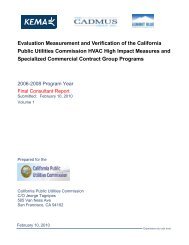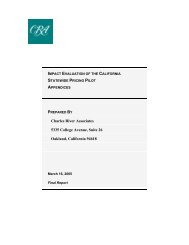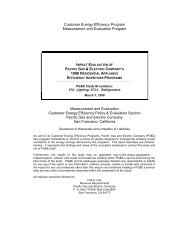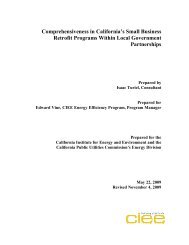Long Term Energy Efficiency Strategic Plan - California Public ...
Long Term Energy Efficiency Strategic Plan - California Public ...
Long Term Energy Efficiency Strategic Plan - California Public ...
Create successful ePaper yourself
Turn your PDF publications into a flip-book with our unique Google optimized e-Paper software.
The largest user of natural gas is petroleum sector, with about half going to feedstocks, followed by food<br />
processing.<br />
Industrial Natural Gas Usage by Industry Type,<br />
2003–Overall<br />
Food<br />
Tex tiles/Apparel<br />
Lumber/Furniture<br />
Paper<br />
Printing<br />
Chemicals<br />
Petroleum<br />
Rubber/Plastics<br />
Stone/Clay /Glass<br />
Prim Metals<br />
Fab Metals<br />
Ind Machinery<br />
Electronics<br />
Transp Equip<br />
Instruments<br />
Miscellaneous<br />
0 200 400 600 800 1000 1200 1400 1600<br />
Millions of Therms (Mth) per Year<br />
Source: KEMA 2006, <strong>California</strong> Industrial Existing Construction <strong>Energy</strong> <strong>Efficiency</strong><br />
Potential Study<br />
Several factors unique to the industrial sector require an approach to <strong>California</strong>’s energy efficiency and<br />
greenhouse gas (GHG) reduction goals different from that used in the commercial and residential sectors:<br />
• Industry uses a large quantity of energy<br />
and other resources via complex and<br />
proprietary processes to create and<br />
bring products to market. Products, to<br />
varying degrees, have embedded<br />
energy that traditionally cannot be<br />
“zeroed out”, although technology is<br />
changing (e.g., the developing<br />
technologies for “zero energy” cement,<br />
dry walls, etc.)<br />
• Industrial facilities in <strong>California</strong> are<br />
increasingly managed by corporations<br />
that reside outside of the state or<br />
outside of the country and that view<br />
these facilities as mobile assets in a<br />
competitive global marketplace.<br />
• <strong>California</strong> industry is highly diverse in<br />
type, size, and operation; uniform<br />
programs often will not match corporate<br />
or facility needs.<br />
• Industries are subject to multiple<br />
policies and rules in resource areas<br />
(e.g. air quality, water quality, energy<br />
efficiency, GHG reductions, solid waste<br />
management), where compliance can<br />
raise competing objectives and<br />
outcomes.<br />
INDUSTRIAL SECTOR SECTION 4 – PAGE 44











